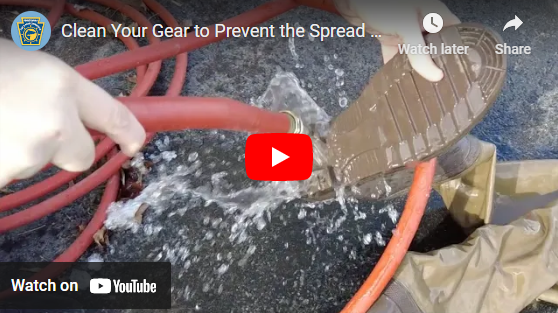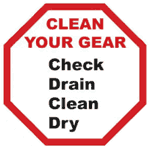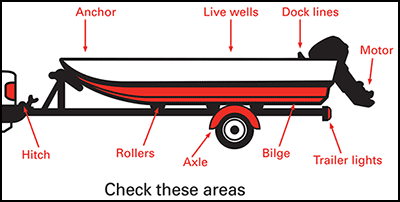CLEAN YOUR GEAR - IT'S THE LAW

Aquatic Invasive Species (AIS) are plants and animals that have been introduced into new ecosystems and have environmental,
recreational, economic or health impacts. These invaders may damage equipment and compete with native species. Anglers and
boaters may unknowingly introduce AIS into new waters.
Do not transport any plants, fish or other aquatic life from one body of water to another. Do not release unused bait into the waters
you are fishing. Dump unused bait in a trash can.
Help reduce the spread of Aquatic Invasive Species by following these simple steps:
- Check
- Drain
- Clean
- Dry
CHECK YOUR EQUIPMENT
Inspect every inch of your boat, trailer and fishing gear before leaving any body of water. Remove and leave behind plants, mud and aquatic life.
Check your boat
- Anchor and line
- Motor lower unit
- Hull
- Trailer hitch, rollers, lights and axle
- Life jackets
- Swimming floats, water skis, wakeboards or tubes
Check your fishing gear
- Shoes or boots
- Clothing
- Fishing vests
- Fishing rod, reel and line
- Hooks and lures
- Tackle boxes
Remove
- Visible plants
- Fish or other aquatic animals
- Mud and dirt
Do not transport any potential hitchhiker, even back to your home. Remove and leave them at the site you visited.
DRAIN
Drain water from all equipment before leaving the area you are visiting. Some species may live for months in water that has not been removed.
- Motors
- Jet drives
- Live wells
- Compartments
- Boat hulls
- Bilge
- Shoes, boots and waders
- Bait buckets
- Life jackets
- Swimming floats, water skis, wakeboards or tubes
- Kayaks (pull open plugs)
CLEAN
Many AIS are microscopic and can't be seen. It's important to clean your gear even if it doesn't appear to have anything on it. Follow the cleaning instructions below after the water has been removed.
- Use hot (140° F) water to clean your equipment.
- Spray equipment with a high-pressure washer. If hot water is not available, a commercial hot water car wash also makes an ideal location to wash your boat, motor and trailer.
- Freezing gear for at least 6 hours will kill most AIS
DRY
Dry everything before entering new waters. Allow equipment to dry to the touch, and then allow it to dry another 48 hours. Thick and dense material like life jackets and felt-soled wading gear will hold moisture longer, take longer to dry and can be more difficult to clean.
STOP AQUATIC HITCHHIKERS
Do not transport any plants, fish or other aquatic life from one body of water to another. Do not release unused bait into the waters you are fishing. Dump unused bait in a trash can.
Tips for
New Zealand Mudsnails:
-
Freeze gear for a minimum of six hours.
-
Soak gear in hot (>120 Fahrenheit) water for at least five minutes.
- Dry gear completey for at least 5 days
IT'S THE LAW
A Waterways Conservation Officer (WCO) may order:
- The removal of aquatic plants or prohibited species from a watercraft, trailer or water-related equipment before transport or before immersing
in Commonwealth waters.
- Confinement of the watercraft at a mooring, dock or other location until the related equipment is removed from the water.
- Removal of a watercraft from a Commonwealth water to remove prohibited AIS if the water has not previously been known
to be infected with that species. Find lists of known waters of the Commonwealth with AIS in the United States Geological Survey's Nonindigenous Aquatic Species database.
- A prohibition of a watercraft into a Commonwealth water when the watercraft has aquatic plants or prohibited AIS attached
or when water has not been drained or the drain plug not removed.
- Decontamination of a watercraft, if possible, on site.